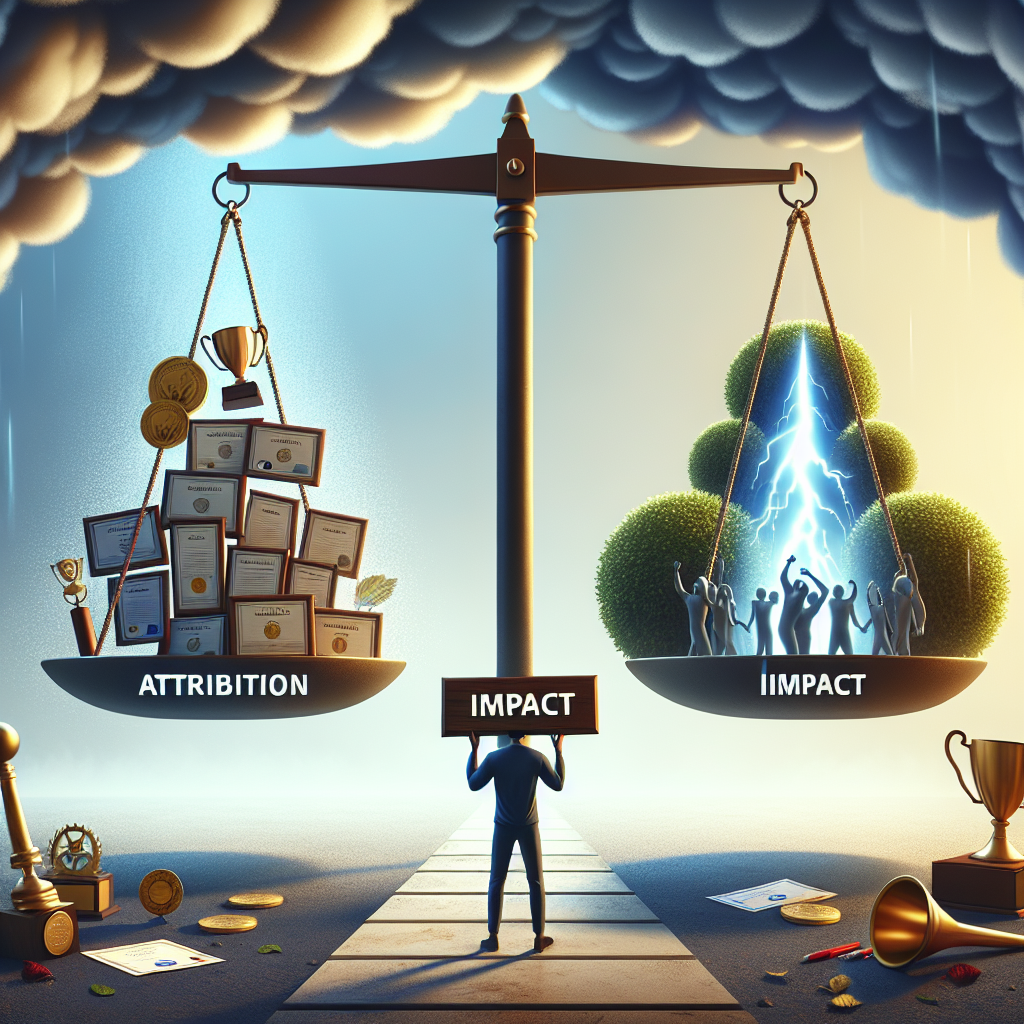-
Table of Contents
- Stop Worshipping Attribution—Measure Impact Instead
- Welcome to the Church of Attribution (Now Please Exit Quietly)
- Why Attribution Is Broken (And Always Has Been)
- Impact > Attribution: The New Marketing North Star
- 1. Define Impact in Business Terms
- 2. Build a Marketing Scorecard (Not a Channel Report)
- 3. Embrace Qualitative Signals
- 4. Invest in Brand (Even If You Can’t Attribute It)
- Case Study: How One SaaS CMO Ditched Attribution and Doubled Revenue
- Truth Bomb
- How to Sell This Shift to Your CEO
Stop Worshipping Attribution—Measure Impact Instead

Attribution is the security blanket marketers won’t let go of. But in a world of dark social, multi-touch chaos, and long sales cycles, it’s time to stop obsessing over who gets credit—and start measuring what actually moves the needle.
Welcome to the Church of Attribution (Now Please Exit Quietly)
Let’s be honest: attribution has become the marketing equivalent of a participation trophy. Everyone wants credit. Every channel wants a slice of the pie. And every tool promises to tell you exactly which tweet, TikTok, or trade show lunch led to that $250K deal.
But here’s the truth bomb: Attribution is a lie we tell ourselves to feel in control of chaos.
In reality, your buyer’s journey looks less like a funnel and more like a Jackson Pollock painting. They saw your CEO on a podcast, read a spicy LinkedIn post, got a Slack message from a peer, and six months later—boom—they’re in your pipeline. Good luck attributing that.
Why Attribution Is Broken (And Always Has Been)
Let’s break down why the attribution model is fundamentally flawed in today’s marketing landscape:
- Dark Social is Untrackable: Conversations in Slack groups, DMs, and private communities don’t show up in your CRM.
- Multi-Touch is a Mirage: Even the most advanced models can’t accurately weigh the influence of each touchpoint.
- Sales Cycles Are Long and Nonlinear: B2B buyers don’t follow a script. They ghost, resurface, and binge your content at 2 AM.
- Attribution Tools Are Biased: Most tools favor the channels they’re built to track. Surprise: your ad platform thinks ads are the hero.
Still clinging to your UTM links like a toddler with a blankie? It’s time to grow up.
Impact > Attribution: The New Marketing North Star
Instead of asking, “Which channel gets credit?” ask, “What actually drives revenue, influence, and brand equity?”
Here’s how to shift your mindset from attribution to impact:
1. Define Impact in Business Terms
Impact isn’t clicks or impressions. It’s:
- Revenue growth
- Pipeline velocity
- Brand preference
- Customer retention
- Market share
If your marketing isn’t moving these needles, it’s just noise.
2. Build a Marketing Scorecard (Not a Channel Report)
Stop reporting on channel performance in silos. Instead, build a unified scorecard that tracks:
- Influence on closed-won deals
- Share of voice in your category
- Engagement from ICP accounts
- Brand search volume over time
- Customer feedback and NPS trends
These are the metrics that matter. Not whether your webinar got 37 or 42 signups.
3. Embrace Qualitative Signals
Not everything that counts can be counted. Some of your most valuable insights come from:
- Sales call recordings (“They mentioned our podcast!”)
- Customer interviews (“I saw your CEO on LinkedIn.”)
- Community chatter (“Everyone’s talking about your new feature.”)
These signals don’t fit neatly into a dashboard—but they’re gold.
4. Invest in Brand (Even If You Can’t Attribute It)
Brand is the ultimate force multiplier. It shortens sales cycles, increases win rates, and drives up pricing power. But it’s notoriously hard to attribute.
That’s why most CMOs underinvest in it. Don’t be that CMO.
Instead, measure brand impact through:
- Direct traffic growth
- Branded search volume
- Social share of voice
- Customer sentiment analysis
Brand is the tide that lifts all boats. Attribution is the guy arguing over who paddled harder.
Case Study: How One SaaS CMO Ditched Attribution and Doubled Revenue
Meet Sarah, CMO of a mid-market SaaS company. For years, her team obsessed over attribution. Every campaign had to be trackable. Every dollar had to be justified.
The result? Safe, boring marketing. No risk. No creativity. No impact.
Then Sarah flipped the script. She stopped asking, “Can we track this?” and started asking, “Will this move the needle?”
She:
- Launched a bold podcast with zero attribution tracking
- Invested in community-led growth through Slack groups
- Empowered her team to create spicy LinkedIn content
- Stopped reporting on MQLs and started reporting on pipeline velocity
In 12 months, revenue doubled. Sales cycles shrank by 30%. And brand awareness exploded.
Attribution didn’t get her there. Impact did.
Truth Bomb
“Attribution is a compass in a funhouse mirror. It points somewhere—but never where you actually are.”
How to Sell This Shift to Your CEO
Let’s be real: most CEOs love attribution because it feels like control. So how do you sell them on impact?
- Speak their language: Talk revenue, not reach.
- Show the limits of attribution: Walk them through a real buyer journey and ask, “Which touchpoint gets credit


Leave a Reply